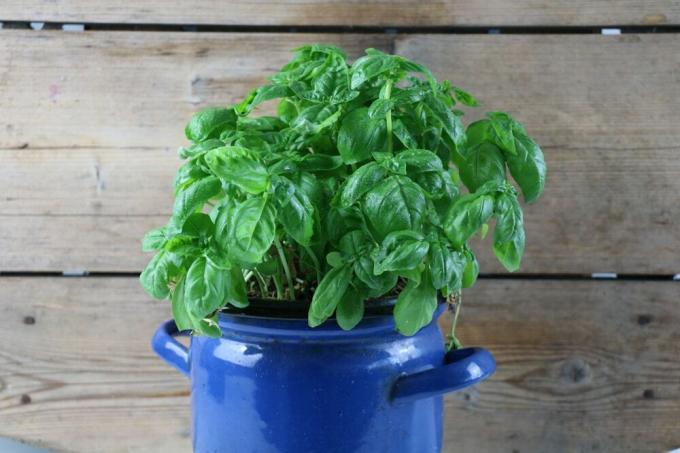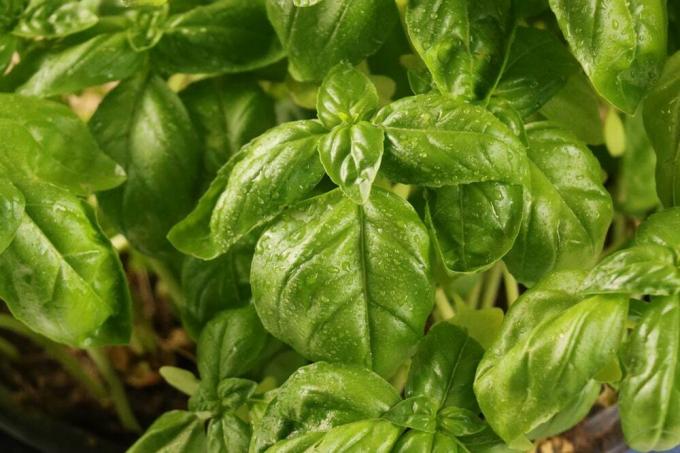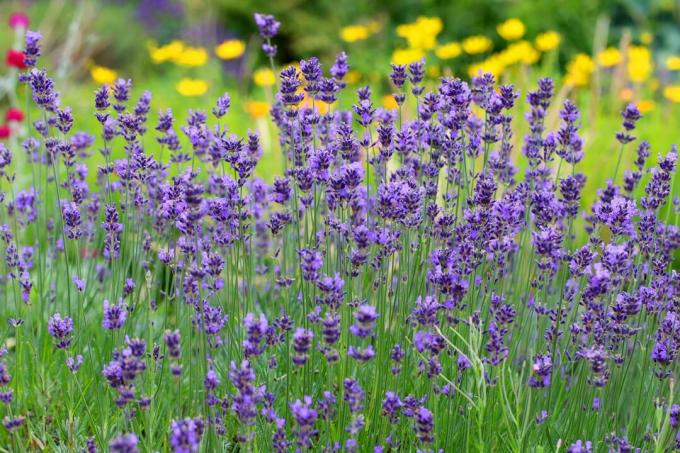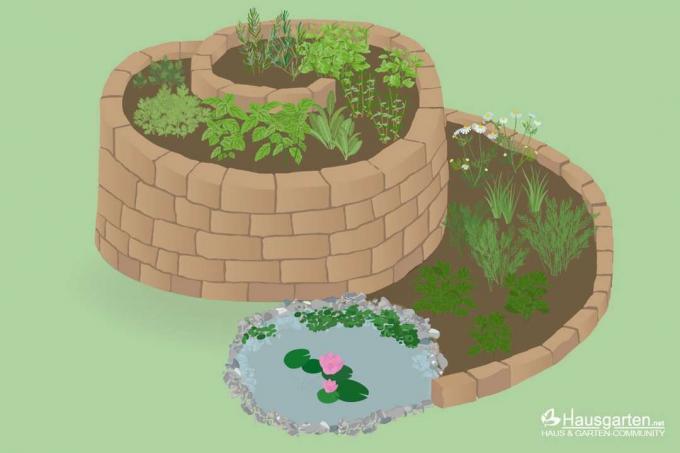

Table of contents
- Characteristics
- Buy pre-grown potted plants
- Location
- substrate
- repot
- Care
- Pour
- Fertilize
- Cut
- hibernate
- multiply
- pests and diseases
- stem rot
- leaf spot disease
- Lucerne Mosaic Virus
- Fusarium wilt
Basil is grown in pots in many households. The plants are often taken with them when they go shopping and then completely used up or die due to a lack of care. It is quite easy to cultivate the royal herb even in smaller vessels. If the location is also right, a specimen can even be preserved for several years and used permanently in the kitchen or elsewhere.
Characteristics
- Genus: Basil (Ocimum)
- Family: Lamiaceae (Lamiaceae)
- Trivial names: royal herb, basil, basil herb
- Upright herb, annual or perennial depending on how it is kept
- Growth height: 20 - 60 cm
- Leaves: oblong leaves with toothed or smooth margins, colored differently depending on the species
- Flowers: zygomorphic whorls in annual inflorescences, colored differently depending on the species, mostly white
- Flowering period: early June to mid-September
- Origin: northwestern India (not confirmed with certainty)
- is used as a kitchen herb due to its ingredients
Buy pre-grown potted plants
The necessary care measures when keeping the royal herb are much more difficult if you have purchased a weakened specimen. Typically, the spice is bought at the supermarket. However, these specimens are bred exclusively for quick consumption. If you want to be able to enjoy your Basilia for a longer period of time, you should purchase plants from a nursery or specialist shop if possible. Weekly markets are just as suitable. Pay attention to the following points when choosing:
- dried substrate
- Stem and leaves light green
- weak aroma
- pest infestation
- leaf discolouration
- smell of rot

If it's just a dry substrate, faint aromas, or light green plant matter, feel free to purchase the plant and spice it up again. There are seven species and subspecies to choose from:
- basil (bot. Ocimum basilicum)
- bush basil (bot. Ocimum minimum)
- Tulsi (bot. Ocimum sanctum)
- Horapa (bot. Ocimum basilicum var. thyrsiflora)
- lemon basil (bot. Ocimum citriodorum)
- Tree basil (bot. Ocimum gratissimum)
- African basil (bot. Ocimum kilimanjaricum)
Take your time when choosing, because each of the species has different properties and aroma. The lemon basil inspires with a fresh citrus aroma, while the Horapa is reminiscent of aniseed or liquorice.
Location
An important point for the successful cultivation of Basilia in pots is the location. Since basil is a genus from the tropics, it is important to adapt the location to the herb's requirements. This is the only way to ensure good growth and strong aroma development. The king herb biscuit should have the following characteristics regardless of each type:
- Light requirement: sunny
- Partial shade tolerated for short periods
- warm
- Minimum temperature: 12°C
- protected
When keeping it, it is important not to leave the plant behind the glass all the time. Basilia likes a place in the fresh air and especially enjoys the summer outdoors. If you can make this possible, you will look forward to a rich harvest and fragrant herbs on the balcony, terrace or in the garden. If you have just bought and repotted your plant, you should not place it in the sun too much over the first week, but rather get used to it slowly. This will prevent the leaves from drying out, as well as possible sunburn. The plant first has to adapt to the increased amount of light.
substrate
Not only the location is essential for keeping and cultivating basil in pots. In order to provide the mints with sufficient moisture, nutrients and a good stand, the substrate is just as important. The herb requires a special substrate composition in order to be able to establish itself in it, which increases vitality and makes overwintering easier. Design the substrate as follows:
- relaxed
- permeable
- nutritious
- humorous
- pH: 6.5 - 7.2
- of high quality
As you can see, basil needs to be planted in soil that is particularly resistant to waterlogging, as the plant is very sensitive to this. A combination of humic herbal soil, which you enrich with sufficient compost, is well suited for an ideal structure and supply. Herb soil has the advantage that it is not too firm and therefore ensures an effective fit and good permeability. This is exactly what the basil wants.
repot
As mentioned above, repotting is an important step in the care of basil and is not only necessary for newly acquired specimens. While repotting should be done immediately after purchase, it's important to always move the plant to a larger pot if the old one is too small. This should also be the case with compacted or overly old substrate that has problems storing nutrients. If you want to repot in spring, you should do so in May. A new planter that is larger than the old one and has drainage holes is important for this. Proceed as follows when moving the plant to fresh substrate:
- create drainage
- Drainage material: gravel
- fill in some substrate
- Remove Basilia from old soil
- Gently shake off the soil
- check root
- remove dried, dead or rotten roots
- carefully place in new pot
- fill with substrate
- press gently
- moisten well

If you have a very large plant, it is best to divide it. More than ten main stems in a pot are not recommended due to lack of space unless you have plenty of pot space. If you divide the plant, you don't necessarily need larger pots, just fresh substrate.
Care
A big advantage of cultivating the royal herb is the manageable care. Although it requires a lot of care because it is a tropical plant, once the rhythm has set in, care is much easier. You must pay particular attention to the water additions and overwintering. If the plant is not cared for as necessary, the royal herb quickly suffers from diseases and pests. But these can also be combated.
Pour
Basil is a tropical plant and heavily dependent on adequate moisture. For this reason, you have to water them regularly to guarantee the supply of moisture. Besides, you have to be careful not to let the plant drown. Waterlogging quickly leads to a variety of problems with basil, especially in the pot. The following points will help you with watering:
- water more often when there is a lot of sun
- pour when the substrate surface has dried
- Use finger test
- give small amounts of water
The water should never stand still in the coaster. It is best to pour this off after a few minutes so that the moisture does not accumulate too much and the roots end up rotting, which can eat away at the whole plant. It is best to use low-lime water for watering, as basil can only withstand small amounts of lime. Well suited for this are:
- stale tap water
- filter water
- rainwater
When watering, you should never water directly on the kingweed. This increases the risk of fungal diseases and burns on the foliage in strong sunshine. Only the substrate is cast so that this risk can be contained.
A notice:
Never put your basil pot in the rain. In most cases, this leads to waterlogging and can severely damage the plant, which makes rain protection very important in summer.
Fertilize
Like many other plants from the tropical regions of the world, it is important for the royal herb to supply it with nutrients at the necessary times with the right fertilizer. In order for the basil to develop its intense aroma and at the same time maintain its vitality, regular fertilization throughout the year is necessary. Fertilize even in winter, as the crop doesn't really hibernate, especially when you're harvesting it. Fertilization works as follows:
- Frequency: 2-4 weeks
- use high-quality herbal liquid fertilizer
- administer via irrigation water
- ideally fertilize in the morning
The liquid fertilizer is much better suited for fertilizing, as it can be administered more easily with the irrigation water and is distributed more quickly in the substrate. You should fertilize in the morning so that the midday sun does not really burn the fertilizer into the substrate. When you fertilize, the fertilizer, like the irrigation water, is not given over the leaves.
A notice:
If you harvest your Ocimum specimens regularly and want to cultivate them over a period of several years, you should only fertilize with organic-based products. This prevents ingestion of chemicals that could adversely affect your health.
Cut
In addition to fertilizing and watering, pruning the basil is another essential care step. It is particularly important to prevent the basil from flowering, otherwise the aroma of the leaves will noticeably decrease. During flowering, they even take on a strong bitter aroma. Pruning is done throughout the year as desired, with increased intensity over the summer. Only cut off the shoot tips and never cut into the woody part of the perennial basil. Always leave the bottom pair of leaves on each shoot to encourage new growth. This will also keep the basil in check if it grows too fast for you.
Tip:
If you want to use the basil in the garden as insect pasture, save yourself the cut in the spring and wait for the flowering. Shortly before the end of flowering, simply cut the kingwort and use the flowers to make vinegar or as part of a salad, as they are edible.
hibernate
Overwintering protects Ocimum from the low temperatures that prevail in central Europe over the winter. Proceed as follows:
- move inside when the temperature is below 15°C
- Winter quarters temperature: 15°C – 20°C
- bright
- protected from drafts
- do not place over radiators
Sufficient humidity is very important during this period, otherwise the royal herb will suffer from the drought. Use a spray bottle or an automatic humidifier for this. If you have problems with sufficient light, it is best to use plant lamps until spring arrives.
multiply
Yes, basil plants can be propagated by sowing or cuttings in addition to division. If you intend to sow, you must either allow the plant to flower or purchase seeds:
- Time of sowing: April
- Substrate: 2 parts potting soil, 1 part sand
- moisten
- fill in breeding vessel
- Max. twelve seeds per pot
- place on earth
- Lightly press
- Cover the culture vessel
- use clear film for this
- alternatively mini greenhouse
- Temperature: 20°C – 25°C
- Location: bright
- air daily
- Keep substrate moist
- Seeds germinate quite quickly

The seedlings are then selected and placed in their own pots with a suitable substrate. The cuttings, on the other hand, can be used for propagation all year round. These should be ten centimeters tall and have one or two pairs of leaves. After two to three weeks in the water glass, roots should have developed, which allows planting in a pot (maximum ten cuttings per container).
pests and diseases
Despite its origin, basil is quite resistant, but can quickly suffer from fungal or viral diseases. If the herb suffers from one of the following fungal diseases, you must remove the affected parts of the plant immediately and dispose of them in the residual waste. Chemical means are not applicable as Ocimum is used for consumption.
stem rot
Caused by waterlogging and can destroy the entire plant as the roots rot and an unpleasant odor can be heard. The stems can also take on a different color. Unfortunately, in this case you have to destroy the entire plant so that the fungus does not spread further.
leaf spot disease
Yellow or brown-red spots are caused by moisture on the leaves. The basil recovers quickly when the leaves are removed. The individual spots can run into each other, which greatly weakens the plant.
Lucerne Mosaic Virus
If you see yellowed leaves and spots in a mosaic pattern, it is this viral infection. Aphids can also be seen and leaves with deformations or compressions. If the infestation is severe, destroy all of the herb. Otherwise fight aphids and remove infested areas.
Fusarium wilt
This serious fungal disease with a fatal outcome for the plant can be recognized by the yellowing of the leaves, mainly the older ones. In addition, the plant weakens severely. Over time, the herb simply dies and there is no countermeasure.
Pest infestations are also recorded when keeping them in the garden. These include, above all, snails and the caterpillars of the dock owl (Acronicta rumicis), which like to feast on the leaves. You can keep snails away with a snail protection while the moth caterpillars are collected and infested parts are disposed of.
Tip:
Don't worry, a woody stem is not a sign of disease or pest infestation if the leaf and stem color are preserved. All basil species are woody plants that, with years of good care, will grow very well grow robustly and thus the woodiness is a positive aspect when it comes to the plant in the pot goes well.
 Home editorial office
Home editorial office
Learn more about growing herbs

Basil has black dots: what to do?
Especially basil bought in a pot from the supermarket tends to quickly develop black dots or spots on the leaves. This article explains why this is and what helps against it.

14 kitchen herbs that you can really keep in the kitchen
Sometimes a herb garden is only possible on the windowsill. If you don't have your own garden bed, for example, or in the months when the frost freezes the coveted greenery outside. Our list provides an overview of which herbs like the kitchen location permanently.

Parsley turns yellow: Four tips against yellow leaves
If the leaves of the parsley suddenly turn yellow, the so-called parsley disease is usually behind it. This can have many causes. If the outbreak of the disease is to be prevented, only prevention helps. More about this here.

You can combine lavender with these 13 plants
Whether you use it in the kitchen, want to enjoy its fragrance or its beauty, lavender is a must in any garden. Well combined, it can strengthen other plants or protect them from pests. We present the best plant neighbors.

8 tips for cutting and harvesting herbs properly
Fresh herbs from the garden should not be missing in any kitchen. They are versatile, exude pleasant and spicy scents and are a treat for the eye with their pretty flowers. In the kitchen, they can easily replace artificial flavor enhancers.

Herb spiral & herb snail: this is how it's done
A herb spiral or herb snail makes it possible to plant many different varieties in a particularly decorative way. However, this is not the only advantage of these variants of the culture. You can find out how to create them here.



